Asteroids: Picture Gallery
The asteroids are a very large group of small mainly rocky objects orbiting in several bands between Mars and Jupiter. They are generally thought to be debris left over from the formation of the solar system which was unable to coalesce into a "proper" planet due to the disrupting influence of the gravitation of the giant planet Jupiter. Only a few asteroids are of any size, with just one of 600mls diameter and three more at about 300mls. In fact, these four together constitute over half the mass of the entire asteroid belt!
Being small and relatively far away, the asteroids are rather dim and thus quite hard to image. Just one, Vesta, is (theoretically!) a naked-eye object but it would need crystal clear skies, a very dark night and excellent eyesight to see it in practice. It, and the other three of the "big four" (Ceres, Pallas & Juno), can be seen in binoculars though.
Ceres
Discovered by Giuseppe Piazzi on New Year's Day 1801, Ceres is (at a diameter of 590mls) by far the largest of the asteroids, containing about 32% of the total mass of the belt. It is almost certainly the only one to have a spherical shape and this has led to it being officially designated a dwarf planet. As mentioned above, it never reaches naked-eye visibility but in February and March 2009 it was unusually bright due to its opposition distance (closest approach to the Earth) being the smallest since 1857! This was because opposition was only a couple of weeks after its closest approach to the sun and just two months after the Earth's farthest distance from the sun i.e. very near to the time when the distance between Earth and Ceres would be minimised. Despite this, as with any target that does not show a disc it was still necessary to photograph the correct point of light! Fortunately, on this occasion Ceres crossed a distinctive group of stars at opposition, making it easy to find and its motion particularly clear.
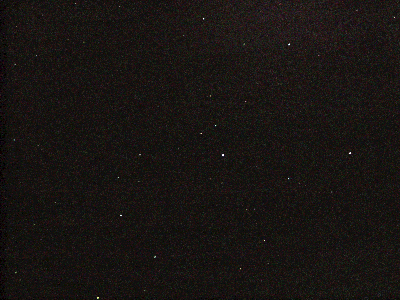
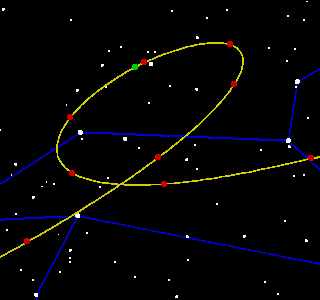 | The group of stars in question is the isosceles triangle in the centre of this image, a section of sky 10deg wide and 71/2deg high sitting on the back of the constellation of Leo, the Lion. There aren't any named stars here, however, so all I can say is that the one at the tip of the triangle (the brightest one in the frame) is known as 54 Leonis. But where is Ceres? Click or tap on the image and all will be revealed! Or, if your eyesight is in need of a check-up, click/tap again for a close-up view.
The images were taken on 28th Feb. and 1st, 5th & 6th March (it was cloudy from 2nd to 4th March!) and show two main things of note. Firstly, Ceres moves from "left to right" instead of the more usual motion from right to left (i.e. west to east). Secondly, even with just the four positions shown, I think it is clear that the track taken by Ceres is curved - slightly downwards in fact. The first observation confirms that it was at or near opposition at the time - see my page on opposition loops here for an explanation of this behaviour. Opposition was actually at 1:34pm on 25th February. The second suggests that, for the curved nature of Ceres' path through the sky to be so easily noticeable, its opposition loop was markedly oval/circular rather than zig-zag. This is indeed true: at nearest approach it was only 71/2wks before the most northerly point in its orbit and it has an orbital inclination of 10.59deg (compared to 1.85deg for Mars), two factors which the Opposition Loops page tells us will give a large visible loop. The lower image confirms this - it is a plot made with the SkyMap program of the position of Ceres against the stars of Leo over a period of eight months, starting at 1st November 2008 at mid-right. A red blob marks the start of each successive month and the green blob shows the point of closest approach. The stars forming the triangle mentioned above are easily seen in the mid-upper section close to the mark for 1st March. The situation in 2000 was slightly better from the "large loop" point of view, as Ceres was then just 61/2wks after its most northerly point: it was fractionally further away from the Earth though. |
The interesting opposition loops traversed by Ceres encouraged me to undertake a detailed exploration of various aspects of the dwarf planet's orbit, including periodicities in the dates of its oppositions and the influence of the nearby giant planet Jupiter. As ever in these pages, I realise this level of detail may not be of general interest so I have placed the information on a separate page: click here to explore what turned out to be a most intriguing topic!
Pallas
The second asteroid to be discovered (by Heinrich Olbers, on 28th March 1802), Pallas has a diameter of 340mls which makes it slightly larger than Vesta. It is, however, much lighter due to its lower density, comprising 7% of the mass of the asteroid belt. It has a low albedo [reflectivity] and so despite its size it is never very bright as seen from Earth: in fact it never exceeds magnitude 6.49.
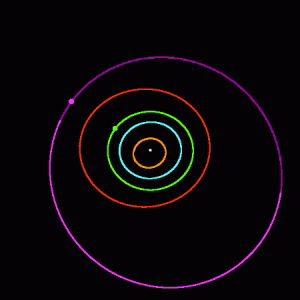 | Pallas' orbit is considerably eccentric and highly inclined (0.231 and 34deg respectively), and this geometry usually contrives to keep it far from the Earth, with a mean magnitude at opposition of just 8.0. However, as shown by the diagram on the left (where the Earth is in green and Pallas is in pink/purple) in February 2014 it was close to perihelion at opposition, which meant that it was considerably nearer to the Earth than usual, and thus brighter - mag. 7.0 in fact - making it much easier to observe. It was also quite close to the ascending node of its orbit (one of the two points where the orbit cuts the general plane of the solar system), indicated on the diagram by the change in colour of its orbit - the darker colour shows where it was below the general plane of the solar system, the lighter colour shows where it was above. This also helps to reduce its distance from the Earth. |
Actual observation requires the skies to be clear, however, and given that 2014 started with the worst weather for 250yrs things were not looking good! The actual day of opposition (23rd) passed without a glimpse of the skies but, remarkably, we finally saw the stars on the evening of 25th February. I soon picked up Pallas in binoculars, adjacent to a distinctive group of stars which not only framed it nicely but also enabled an easy comparison of its magnitude. Miraculously, it was clear for the next two nights also! Normality resumed after that, but at least I had had three opportunities to get some images, as shown below.
 | The star to the upper right of the images is 34 Hydrae, an undistinguished star of magnitude 6.4 about 22/3 deg. to the east of the slightly better known magnitude 2 star Alphard. The bright stars comprising the base of the triangle to lower right are mag. 6.3, with the pair to mid centre-left at mag. 7.0. The distance between these two pairs is 12/3 deg. And Pallas? Oh yes - it's the one nearly in the middle, clearly about as bright as those to its left and therefore mag. 7.0 as well, as predicted.
Click or tap on the diagram to view the same area on each of the next two days - the movement of Pallas is very clear - and finally for a "movie" of the three images in sequence. |
Juno
Although it was the third asteroid to be discovered (by Karl Ludwig Harding on 1st September 1804), with a mean diameter of 145mls Juno is only the tenth largest. The reason it was discovered so early seems to be because its surface is unusually reflective and so it is brighter than its size alone would indicate. On the other hand, its orbit is very eccentric (even more so than Pluto) and so its observed brightness varies considerably. During oppositions when it is at its closest to the Sun it can reach magnitude 7.5 but is usually only at 8.7 - barely visible in binoculars.
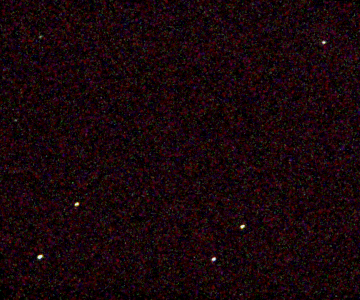 | One such favourable opposition was in 2009 so this seemed an ideal time to capture an image. Opposition was on 21st September but I had my first try during a spell of fine weather in late August as Juno was then close to a distinctive group of stars which would make identification easier: see left. Click on the image to reveal Juno as it moves across the starfield from 20th to 23rd August (click again to go back to just the stars). My astronomy program gave Juno as mag. 8.3 during this period, almost exactly the same as the faint stars to top left and much dimmer than the four near the bottom, which are about 2 magnitudes brighter. |
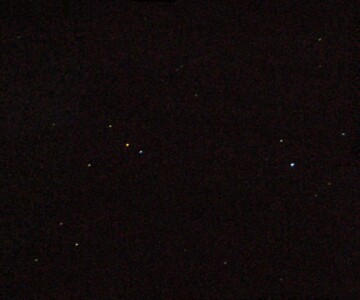 | I next picked up Juno on 12th & 18th September, just before opposition (lots of cloudy nights in between!). In this composite image it is firstly at the apex of the thin triangle of faint stars near top middle and then it's the lower of the two faint stars near middle right. Click on the image to label Juno with the dates (click again to remove the dates). Note the yellow and blue colour of two stars in the cluster just left of centre. These colours are real, not artefacts of the camera, and could be clearly seen in binoculars. The colour of a star indicates its temperature - yellow stars are cool and blue stars are hot. |
| I was somewhat luckier with the weather close to opposition. This composite shows Juno on 18th (same position as above), 20th, 22nd, 25th & 26th September. Again, a click will show the dates. It was given as mag. 7.6 at this time and the image agrees with this as it is just fractionally brighter than the stars it is next to on the 25th & 26th (mag. 7.9). Note that this image and the top one cannot be compared for brightness as the top one had to be more heavily enhanced to show the fainter Juno - the extra "noise" comes from this processing. The scale of all three images is the same though, showing that, taking into account the differing numbers of days between the positions, Juno's movement across the sky was constant through opposition (on 21st September). | 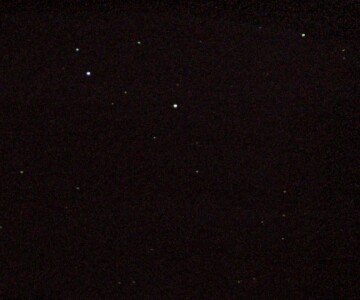 |
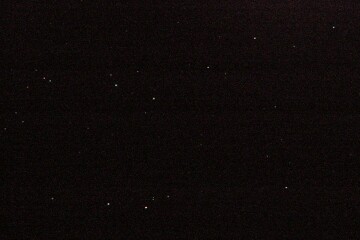 | When checking on Juno's position with my astronomy programs I noticed that the major planet Uranus was not far from Juno. This "wide-angle" shot shows them both. If I tell you that it was taken on 20th September you can probably find Juno easily enough, and Uranus is in the top right corner. Click when you think you've found them. As a guide to scale, the separation between the two is 5deg (10times the apparent diameter of the Moon): not really close enough to be called a conjunction. By comparison, the movement of Juno from 18th to 26th was just over 2deg. |
Vesta
Vesta may be called the second "biggest" asteroid, being at 330mls in diameter only slightly smaller than Pallas but much heavier. It is estimated to contain 9% of the total mass of the asteroid belt. It is the brightest asteroid, reaching magnitude 5.1 at opposition. It still looks just like a star though so, as with other such targets, a good way to get a convincing image is when it comes close to an outer planet. This does not happen all that often so I was pleased to discover that Vesta would get within 1/3 degree of Jupiter late in August 2007. The downside was that Jupiter would be quite low in the sky so weather conditions would be critical! A fairly grim August finally relented on the 25th, so I was able to get some shots that evening in an almost perfectly clear sky - two even had Vesta on them: yippee! The story of the next three nights was cloud, cloud and more cloud but a brief clearance on the 29th gave a further opportunity to capture some images. The evening of closest approach was showery but as the month ended the skies again cleared for an extended period on the 31st allowing me to capture the best shots so far! The first couple of days of September were cloudy and grey so by the time I was able to see the stars again on the 3rd Vesta had moved quite a long way from Jupiter - in fact it was no longer in the same camera frame as my reference star so I decided to call a halt after that. It goes without saying that the next few nights were clear as crystal - that's the English weather for you!! However, I had managed to get four good observations and thus establish Vesta's track so, considering the conditions, I was quite pleased with my first "asteroid hunt".
The images were taken with a Minolta Dimage A200 digital camera mounted on a tripod, using a 200mm lens with a x4 digital zoom. Exposure was generally the maximum the camera would allow - 4secs at f3.5, 800ASA equivalent. The "noise" in the background is precisely that - electronic noise generated by the camera when viewing a dark field at the very high sensitivity implied by the 800ASA setting. Reducing the ASA would improve this problem but at the risk of probably not capturing Vesta!
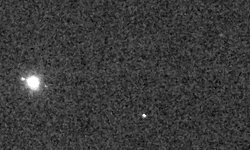 | 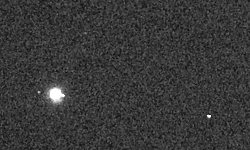 |
| This picture is the sum of two images taken on 25th August, contrast adjusted and converted to black-and-white but not otherwise enhanced. The large over-exposed blob to the left is of course Jupiter (plus some of its moons), and the bright spot lower down is the star Omega Ophiuchi. Vesta is the much fainter spot to top right - the separation to Jupiter on this date was 11/4 deg. | By the 29th Vesta had moved considerably closer to Jupiter (look to its "1 o'clock" position). The separation was now just 1/2 deg. Less obviously perhaps, Jupiter had also moved: compare its distance from the star in this image to that in the one on the left. This picture is the sum of six images, processed as before and balanced to be the same brightness as the previous one. Note that the orientation is slightly different as the images were taken an hour earlier. |
| |
 | 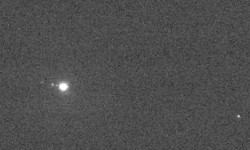 |
| Two days later Vesta had "overtaken" Jupiter: it is now at top left - the separation is just under 1/2 deg, only slightly more than at closest approach the day before. This picture is a stack of four images, but in fact that night the sky was so clear that Vesta was visible on several single images. | To make the point about the good "seeing", this is a completely unprocessed single image taken on the 31st: it has simply been converted to black-and-white. While Vesta is clearly visible at top left it is much fainter than in the other images, showing how stacking and image processing can improve matters. |
| |
 |
| By 3rd September Vesta had moved so far that I've had to increase the width of the picture to show everything! In fact, capturing all three objects was a bit of a problem as the separation was greater than the field of view of the camera. I thus reduced the digital multiplier to x2 to compensate: the picture is at the same scale as the others though. As ever, it's a stack - of four images this time. |
| |
 |
| This image is a composite of the four above, each having been rotated to align correctly with one other: Jupiter and Vesta are labelled with the dates they were in a given position. The movement of Jupiter is now much more obvious, as is the fact that the paths of the two are not parallel - this is, in part, a consequence of the inclination of Vesta's orbit to the plane of the solar system (7 degrees). |
| |
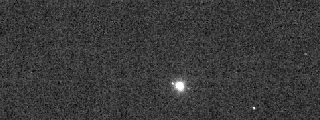 | 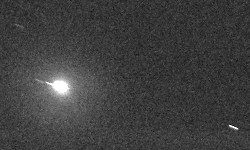 |
| This movie shows Vesta and Jupiter moving across the sky relative to the fixed star. The pale area across the fourth image is actually a slight cloud band which I didn't notice when taking the pictures! | Just to dispel any lingering doubts that all I've been showing you is carefully selected camera noise (!), here's a long exposure shot [15sec] with the images of Vesta, Jupiter (plus moons) and Omega Ophiuchi extended into trails. See - it really is there! |
| |
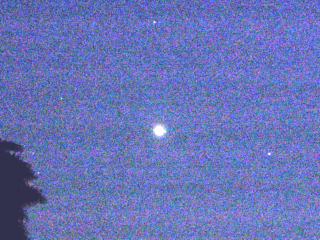 | And finally - a pretty shot! A "wide angle" view of the situation on 4th September, showing (clockwise from the tree at bottom left) a pair of magnitude 7.6 stars, Vesta [magnitude 7.3], magnitude 6.3 star, Omega Ophiuchi [magnitude 4.4] with Jupiter in the centre. To find out about the magnitude scale, click here. |
Very close conjunction between Ceres and Vesta
A close conjunction (or, more properly, an "appulse") between two major asteroids is one of the rarest planetary phenomena: in fact, there are just three of them in the 21st Century (Ceres/Vesta on 5th July 2014, Pallas/Juno on 9th March 2040 and Ceres/Vesta again on 22nd June 2081). This is because their orbital periods are rather similar (so it takes a long time to "catch up" again after being close on a given occasion) and their orbits are often quite inclined (so their paths across the sky rarely coincide). It is thus all the more remarkable that Ceres and Vesta would pass just 10 minutes-of-arc apart on 5th July 2014 and will do so at a mere 6.4 arc-minutes in 2081! By comparison, the appulse between Pallas and Juno might be almost be called distant at 1deg 16min!
However, for an appulse to be an "event" it does have to be observable, and the Pallas/Juno opportunity falls rather spectacularly at this hurdle. In fact, closest approach occurs when the pair are almost directly in line with the Sun as seen from the Earth (though "behind" it rather than "in front", of course, as the asteroid belt is considerably further from the Sun than the Earth) and so are completely unobservable. The second meeting of Ceres & Vesta is slightly better, with the pair 36deg from the Sun, but even so they will only be 12deg high at sunrise which means that, taking into account the fact they will be at a rather dim magnitude 8, they will be effectively unobservable even if not literally so. The 2014 appulse is thus the only one with a realistic possibility of being seen - 98deg away from the Sun (and thus still 20deg high at 11pm, well after sunset) and with the asteroids at mag. 7.4 & 6.2 respectively.
Given the extreme rarity of such events I was very keen to observe in 2014. Normally, of course, one would imagine that the weather would be perfect for star-gazing in high summer - but this is England! True to form, we had poor weather with rain and clouds for the days nearest to the appulse so I was, unfortunately, not able to see the closest approach. Things were more favourable a little earlier though, so I was able to capture some images on 30th June and 1st & 3rd July, as well as during a fortuitous partial clearance on the 6th.
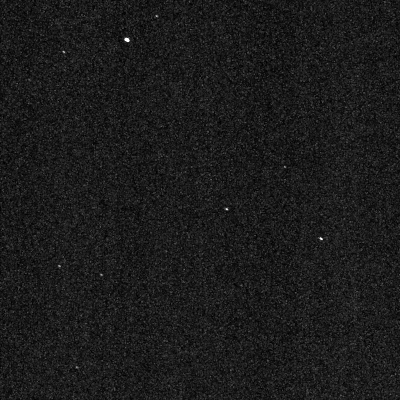 | The first image "sets the scene" - I have removed the asteroids to avoid confusion. The bright star towards the top is Heze, more formally known as Zeta Virginis, a magnitude 3.4 star lying about one third of the way up from Spica (Alpha Virginis) in the direction of Arcturus (Alpha Bootis). The stars in the triangle to mid-right range from magnitude 6.0 to 7.4, with those making up the triangle to bottom left being about 7th magnitude. In terms of scale, the image is about 3 degrees square. |
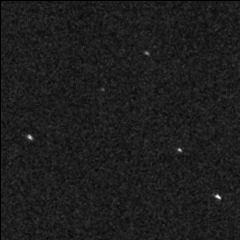 | 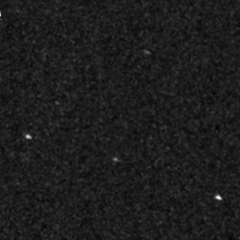 | 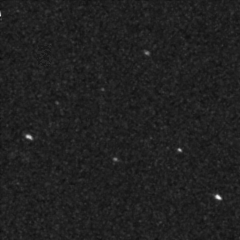 |
| We have now zoomed into the triangle to mid-right, and it is clear there are two extra "stars": these are, of course, Vesta (lower and brighter) and Ceres. In this image, taken on 30th June, they are a little over 23 arc-minutes apart. | Just a day later, and both asteroids have moved considerably and are closer together - just under 20 arc-minutes, in fact. | And to show how they have moved, here's a composite of the two images to the left. It is clear that Vesta is moving faster than Ceres and that their paths are at a slight angle, as required to make them come closer in the days ahead. |
 | 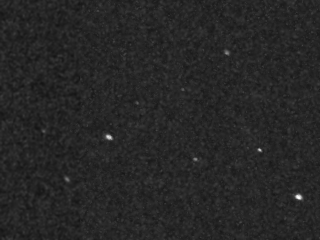 |
| After a further two days (it was cloudy on the 2nd!) the asteroids have moved away from the triangle, and Vesta is continuing to catch Ceres. The separation is now down to 12.7 arc-min. | And here's a composite of all three days, which shows the decreasing distance between them very well. |
Conditions were totally unsuitable for the next two days, which of course included the day of closest approach! The evening of the 6th was then partially cloudy so although I was able to grab a few shots I didn't hold out much hope for seeing much. I was thus highly delighted to find that one of my "lining up" shots had actually caught Vesta quite nicely and could even be persuaded to reveal Ceres after a bit of additional enhancement, as shown below.
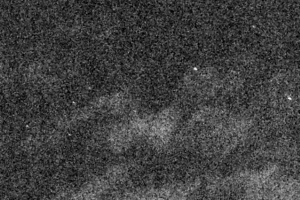 | By this time the pair had left the first triangle seen in the general view behind and were approaching the second one (to bottom left): only the top two stars are captured here. I haven't zoomed in, to allow easier comparison with the general view - the scale is the same as the top image above. The quality of the image is fairly poor, due to the scattered cloud, but even so it is clear that Vesta has now overtaken Ceres and so minimum approach must have passed (as indeed it had). However, their separation is still not much more than the minimum - just 11.3 arc-min in fact. |
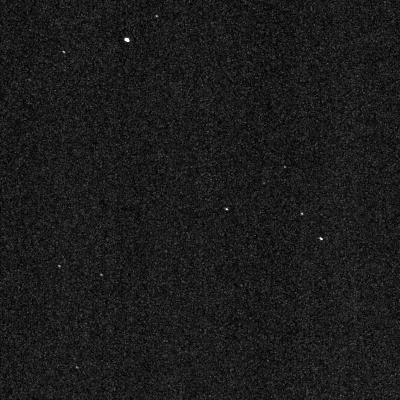 | And finally! If we overlay all the above positions onto the general view and animate the result we see the entire story. Starting at the triangle to mid-right, the pair move toward bottom left, with Vesta catching up Ceres to establish the position of minimum separation and then overtaking as the appulse comes to an end. Pity about the gap in the middle, but that's the British weather for you! |
| I said above that I wasn't able to catch the night of minimum separation, but this image shows what the position would have been: the pink dots indicate where both the asteroids were on the night of the 5th (their position on the other nights is also shown). This isn't the instant of absolute closest approach of course, which was when Vesta was just about to overtake Ceres, but this occured during daylight hours in the UK so would not have been observable. | 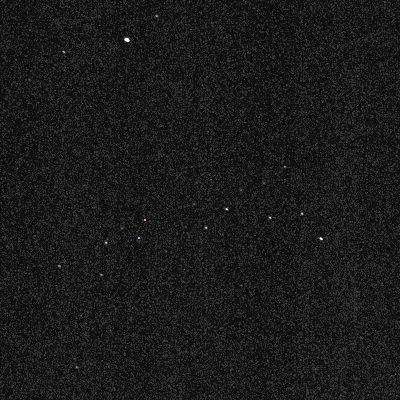 |
We had almost complete cloud-cover and frequent rain for several days from the 7th onwards and so further observations were impossible, although the night sky was (of course!) beautifully clear later in the month. That's it for this century then!
Very close pass by Near-Earth asteroid 357439
The Earth is fairly frequently "buzzed" by bits of interplanetary debris, some of which can come alarmingly close: the occasional one (such as the Chelyabinsk meteorite) even scores a direct hit. The vast majority are however either too small or too far away (or both!) to be easily visible as they pass by. There are rare exceptions though, and the encounter with asteroid 357439 2004 BL86 on 26th/27th January 2015 was one of those.
This "space rock" is estimated to be about 700m in diameter (which is large by Near-Earth standards) and passed only just over 3 times as far away as the Moon. In addition, its orbital configuration was particularly favourable as the point of closest approach was exactly on the Sun-Earth line, so the asteroid was fully illuminated at that instant. Taken together, these factors meant that its brightness was predicted to reach magnitude 9 for a short time - easily bright enough for amateur observation and, I hoped, just about possible for me using only a camera.
Unusually for these occasions (!) the sky was reasonably clear on the night of 26th so I donned my several layers of observing clothing with at least a degree of expectation. I used my planetarium program to tell me where to point the camera as, even with a long exposure (~20sec @ 800ASA), nothing was immediately visible in the captured frames. The asteroid would be moving very rapidly (several arc-seconds per second) and so I took shots about every 3mins, as the shift in position would be quite obvious in this time. I captured two sequences like this, as the asteriod passed in front of two quite distinctive star patterns, separated by about half-an-hour.
Unfortunately, it soon became apparent that the clarity of the sky was not all I had hoped for, as the waxing Moon was showing up some thin high cloud. Not only that, but the camera lens kept misting up due to the low temperature. My confidence that I would be able to capture the asteroid was thus rather dented, as it was always going to be at the limit of visibility (the maximum brightness of mag. 9 would not be achieved until near dawn). And so it turned out, unfortunately, as even with image processing little could be seen.
However! All was not entirely lost. I firstly checked on the Internet to see what others had managed to capture, as a guide to the asteroid's actual brightness, and found that the times the images were stated to have been taken did not match the times given by my planetarium program for the same position relative to the stars (or indeed those on the finder charts given on the British Astronomical Association website). The difference was quite considerable - around 8mins - and so could not have been explained by minor errors in the orbital parameters I used (which were, in any case, freshly taken from the JPL database) nor by any parallax effect due to my viewing site differing from that of the other photographers and that used for the BAA charts. I have no good explanation for this discrepancy, but it might perhaps be due to a perturbation in the asteroid's orbit due to its close proximity to the Earth.
I therefore re-examined my images relative to corrected timings and found just two of them (one from each sequence in fact) where, arguably, there was something in the same place as shown by the planetarium program. The one from the second session looked a bit more hopeful than that from the first, so I subjected this one to more detailed analysis.
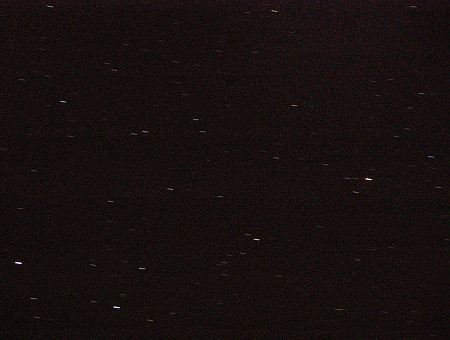 | Firstly though, the orientation shot (to prove I was looking in the right place!). The two bright stars to bottom left are Epsilon Hydrae (upper) and Delta Hydrae (lower). That to mid-right is Beta Cancri (also known as Altarf). If you travelled down and right at 45degrees from Altarf about the same distance as it sits from the top-left corner of the image you would find the very bright star Procyon.
I took my first set of images when the asteroid was within the distinctive pattern of stars just up from bottom-centre, and the second set when it passed just to the right of the two pairs to upper-left of centre. The "almost vertical" pair [which you will see below] are 34 Cancri (upper) and HIP41843 (lower). |
To analyse the image, I firstly set the planetarium program to the time the picture was taken, offset by the 8min mentioned above, and adjusted the scaling of both its view and the image (as well as rotating the image slightly) until two bright stars aligned with the start of the corresponding "trails" on the image. I then adjusted the time slightly to see whether I could also align the asteroid with the start of what I hoped might be its trail - and I could! Encouraged by this, I took a screen-shot of the planetarium view and repeated the process for a time 20sec later - this time aligning the stars with the end of the trails. Once more, the asteroid also lined up!! A further screenshot was thus taken. I then combined both screenshots into one and drew red lines between the start and end points, to produce "pseudo-trails". Finally, I overlaid these trails onto the original (rotated) image to enable comparison between the "actual" and "predicted" views. The results are given below - I've kept the images at quite a large size to a) avoid any problems that re-sampling might cause and b) to enable the faint trails to be seen more easily.
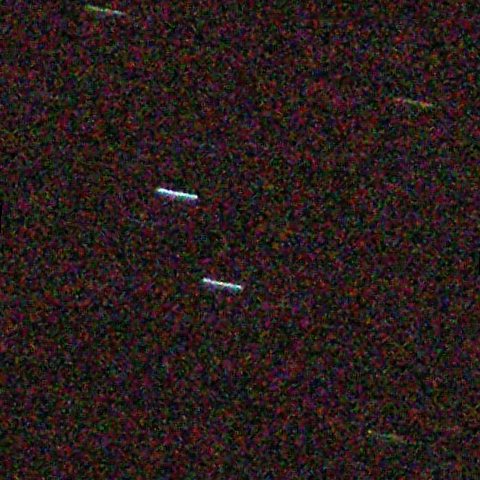 | The first image shows what I captured - it is actually taken from the one above. The bright stars are 34 Cancri (upper), at mag. 6.5, and HIP41843 (lower), at mag. 6.8. The three much fainter ones are (going clockwise from top left) HIP42023, mag. 7.5; TYC-800-410-1, mag. 8.0, and HIP41648, mag. 8.4.
If you click or tap once you will see a negative version of the first image overlaid with the "pseudo-trails" for the bright stars generated from the planetarium view (the original image has been inverted simply so the red lines show up better). It can be seen that the real and pseudo-trails align exactly, showing I have oriented and scaled the images correctly. Another click/tap takes you back to the original image.
A further click/tap now overlays the pseudo-trail for the asteroid. It can be seen that this aligns with a very faint trail on the original image. A final click/tap restores the original again. (Note that moving the mouse pointer off the image at any time resets things back to the beginning). |
To determine how bright the object that left the trail I am ascribing to the asteroid might be, note that there is another very faint trail above and slightly to its right, almost in line with that for 34 Cancri. I had to consult Solex to determine how bright this star this was, as Starry Night does not go down that far, and found it is mag. 9.2. Similarly, there is another faint trail just above and fractionally to the right of 34 Cancri, which is mag. 9.5, and another below and to the left of the star at top left, which is mag. 9.0: I hope you can see them! These three trails are no more distinct than that ascribed to the asteroid, but definitely represent stars which are actually there, and these stars are about the same brightness as the asteroid will have been at this time. I am thus inclined to believe that the presumed asteroid trail is genuine, rather than just random noise. Also, and I think this is the critical factor, this trail is inclined with respect to the others i.e. whatever caused it must have been moving upwards during the exposure, exactly as the asteroid was. I'm thus claiming success!



























